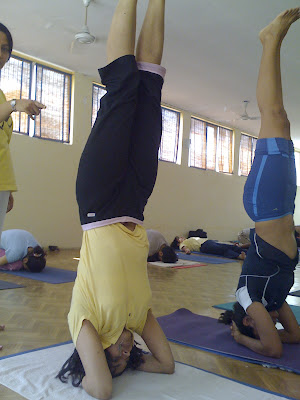

The Headstand (Shirshasana)
This posture may look like imposing to those who haven’t attempted it. Nevertheless, it is an extremely powerful asana. It is called the "king of asanas" because of its overall effect on the whole body. For beginners, it is better to ask a friend to help you with this in the beginning.
Technique
Kneel down on your yoga mat. Interlock the fingers of your hands and place them and your forearms on the yoga mat. Keep the elbows fairly close together.
Place the back of your head into the hollow of the palms (not on the palms or fingers). Rise up off your knees and take a step or two towards your head.
Inhale, and slowly raise the legs until they are vertical. Keep your back straight and try to relax. Breathe slowly and deeply from the abdomen.
Concentrate on the brain or the pineal gland between the eyebrows.
To come down, bend your knees and lower one leg and then the other.
Benefits
The headstand increases circulation to the brain, which causes improved brain function (intelligence and memory) and increased vitality and confidence.
It improves many ailments, such as nervousness, tension, fatigue, sleeplessness, dullness, fear, poor blood circulation, bad memory, asthma, headaches, constipation, congested throat, liver or spleen, for female disorders, the initial stages of eye and nose troubles, and general lack of energy, vitality or self confidence.
It stimulates four of the most important endocrine glands - the pituitary, the pineal, the thyroid, and the parathyroid glands that are responsible for our very existence, for they keep the body mechanism in good working order. Pituitary gland is called the master gland of the body. As a consequence, the practice of the headstand helps us to get relief from many of our troubles, physical as well as mental, or to prevent them. It has a very beneficial effect on the whole body.
It promotes hair growth by increasing circulation to the scalp.
It helps to put the spine into correct alignment.
It restores the position of vital organs by reversing gravity.
The quality of sleep is improved. Poor sleep is often due to an excess of nerve impulses from the reticular formation to the cerebral cortex in the brain. The headstand causes an increase in circulation to the neck, which stimulates the baroreceptors in the neck. This calms the reticular formation down, causing reduced nerve impulses to the cerebral cortex. This results in a peaceful, deep steep.
Because of the many benefits of the headstand, the yogis often refer to it as the 'king of the asanas'.
Caution
Don't do the headstand if you have high or low blood pressure. First get your blood pressure normal by natural means such as good nutrition, aerobic exercise and the other asanas. Even just giving up salt and taking garlic daily (tablets or in cooking) will cause a substantial reduction in your blood pressure.
Atherosclerosis (blocked blood vessels) and any history of strokes are also contraindications to doing the headstand. You must improve your circulatory system first, before attempting it.
If you have any serious eye diseases, ask your eye specialist's advice about doing the headstand.
Avoid this exercise if you are suffering from constipation, when the stool is excessively dry, if you have pus in your ears, if you are suffering from chronic nasal catarrh, or from very weak eye capillaries. Avoid this exercise if you have an organically defective pituitary, pineal or thyroid gland.
If you suffer from a neck injury or advanced arthritis in your neck, again you must improve your neck condition first. See your chiropractor, follow the nutritional principles in this book and do the other asanas to improve your neck. If you have a serious neck condition and you wish to get the benefits of the headstand, you can purchase an inversion apparatus, which gives you all the benefits without compression of the neck. In fact, this equipment produces traction of your neck, so your neck condition will actually improve.
Don't let any minor neck pain stop you from doing the headstand, since most of the weight of the body is actually supported by the forearms. There is very little pressure on the head and therefore very minimal compression of the neck.

No comments:
Post a Comment